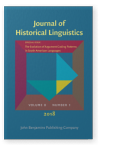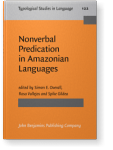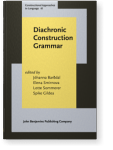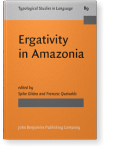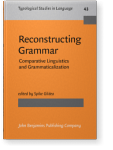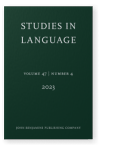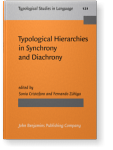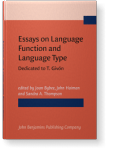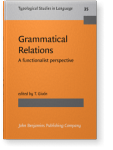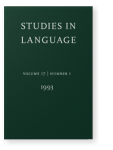Spike Gildea
List of John Benjamins publications for which Spike Gildea plays a role.
Book series
The Evolution of Argument Coding Patterns in South American Languages
Edited by Antoine Guillaume and Spike Gildea
Special issue of Journal of Historical Linguistics 8:1 (2018) v, 167 pp.
Subjects Historical linguistics
Nonverbal Predication in Amazonian Languages
Edited by Simon E. Overall, Rosa Vallejos and Spike Gildea
[Typological Studies in Language, 122] 2018. vi, 407 pp.
Subjects Languages of South America | Semantics | Syntax | Theoretical linguistics | Typology
Diachronic Construction Grammar
Edited by Jóhanna Barðdal, Elena Smirnova, Lotte Sommerer and Spike Gildea
[Constructional Approaches to Language, 18] 2015. xi, 263 pp.
Subjects Cognition and language | Historical linguistics | Syntax | Theoretical linguistics
Ergativity in Amazonia
Edited by Spike Gildea and Francesc Queixalós
[Typological Studies in Language, 89] 2010. v, 319 pp.
Subjects Languages of South America | Morphology | Syntax | Theoretical linguistics | Typology
Reconstructing Grammar: Comparative Linguistics and Grammaticalization
Edited by Spike Gildea
[Typological Studies in Language, 43] 2000. xiv, 267 pp.
Subjects Historical linguistics | Typology
2023 From grammaticalization to Diachronic Construction Grammar: A natural evolution of the paradigm Studies in Language 47:4, pp. 743–788 | Article
The term grammaticalization originally denoted a particular outcome of language change (lexis > morphology), then got expanded to practically all studies involving language change, the processes that create such changes, and a theory modeling these. These expansions have been challenged in the… read more
2021 Chapter 3. Antipassive in the Cariban family Antipassive: Typology, diachrony, and related constructions, Janic, Katarzyna and Alena Witzlack-Makarevich (eds.), pp. 65–96 | Chapter
To date, no published reference grammar of a Cariban language has described an antipassive construction. However, all languages of the family have a cognate verbal morpheme, termed detransitivizer, which prefixes to a transitive verb to derive an intransitive verb. While monovalent, the… read more
2018 Chapter 14. Reconstructing the copulas and nonverbal predicate constructions in Cariban Nonverbal Predication in Amazonian Languages, Overall, Simon E., Rosa Vallejos and Spike Gildea (eds.), pp. 365–402 | Chapter
This paper represents a first effort to characterize the different kinds of nonverbal predicate constructions in the Cariban family, to identify the functions served by copulas, and then to reconstruct the various attested copular forms to a limited number of source forms in Proto-Cariban. Given… read more
2018 The evolution of argument coding patterns in South American languages The Evolution of Argument Coding Patterns in South American Languages, Guillaume, Antoine and Spike Gildea (eds.), pp. 1–6 | Introduction
This special issue of JHL reconstructs the diachrony of a number of innovations in the coding of argument structure, particularly in the domain of verbal indexation, in four Amazonian language families (Chapacuran, Sáliban, Tukanoan and Tupi). It is one result of an international workshop on… read more
2018 Chapter 4. The development of referential hierarchy effects in Sahaptian Typological Hierarchies in Synchrony and Diachrony, Cristofaro, Sonia and Fernando Zúñiga (eds.), pp. 131–190 | Chapter
Sahaptin and Nez Perce, the two languages of the Sahaptian family, have both been cited as case studies in the typological literature on hierarchical patterns in main clause grammar. Nez Perce has ergative case marking on only third person singular transitive subjects, plus a minor pattern of… read more
2018 Chapter 1. Nonverbal predication in Amazonia: Typological and diachronic considerations Nonverbal Predication in Amazonian Languages, Overall, Simon E., Rosa Vallejos and Spike Gildea (eds.), pp. 1–50 | Chapter
2015 Diachronic Construction Grammar: Epistemological context, basic assumptions and historical implications Diachronic Construction Grammar, Barðdal, Jóhanna, Elena Smirnova, Lotte Sommerer and Spike Gildea (eds.), pp. 1–50 | Article
The main goal of this chapter is to discuss the value of the Construction Grammar framework to solving perceived problems with diachronic syntax. As such, one part of this chapter provides a condensed review of previous research in diachronic syntax, including a brief discussion of why many… read more
2010 Nominative-absolutive: Counter-universal split ergativity in Jê and Cariban Ergativity in Amazonia, Gildea, Spike and Francesc Queixalós (eds.), pp. 159–200 | Article
Nominative-absolutive alignment is a form of split-ergativity in two ways. The first split is internal to the clause type, which presents both nominative and absolutive morphological patterns with no corresponding accusative or ergative patterns: most present no nominal case-marking (although in… read more
2010 Manifestations of ergativity in Amazonia Ergativity in Amazonia, Gildea, Spike and Francesc Queixalós (eds.), pp. 1–26 | Article
2000 On the Genesis of the Verb Phrase in Cariban Languages: Diversity through Reanalysis Reconstructing Grammar: Comparative Linguistics and Grammaticalization, Gildea, Spike (ed.), pp. 65–106 | Article
1997 Introducing Ergative Word Order via Reanalysis: Word Order Change in the Cariban Family Essays on Language Function and Language Type: Dedicated to T. Givón, Bybee, Joan L., John Haiman and Sandra A. Thompson (eds.), pp. 145–162 | Article
1997 Evolution of Grammatical Relations in Cariban: How Functional Motivation Precedes Syntactic Change Grammatical Relations: A functionalist perspective, Givón, T. (ed.), pp. 155–198 | Article
1994 Semantic and pragmatic inverse: ‘Inverse alignment’ and ‘inverse voice’ in Carib of Surinam Voice and Inversion, Givón, T. (ed.), pp. 187–232 | Article
1993 The Development of Tense Markers from Demonstrative Pronouns in Panare (Cariban) Studies in Language 17:1, pp. 53–73 | Article
Two synchronic tense-marking auxiliaries in Panare are derived etymologically from demonstrative pronouns. The original pronouns differed in spatial deixis, one marking proximate ('this'), the other distal ('that'). They came to be required between predicate noun and subject in predicate nominal… read more

